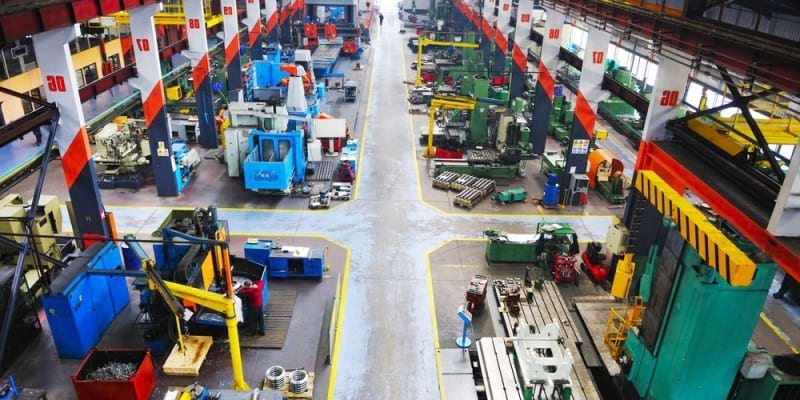Just In Time: an Inventory Management Method

Just In Time (JIT): This article describes jJust In Time or JIT by Kiichiro Toyoda and Taiicho Ohno > practically explained. In addition to what this method is, this article also highlights the role of waste, its relationship with the inventory system, the organization for this method, the Order Quantity and the disadvantages of this method. After reading you will understand the basis and meaning of this quality management method. Enjoy reading!
What is Just In Time / JIT?
Manufacturing companies, especially, rely greatly on excellent logistics. Simply said, the logistical process is about ‘delivering the right products, in the right amount, in the right place on the right time/ date’. Therein lies the essence of Just in Time (JIT).
Nowadays companies need to increasingly compete with each other. This is why it is important that they are able to save money by countering waste of money in business processes.
These LEAN Manufacturing methods offer companies the opportunity to make more profit, by using and wasting the least possible amount of materials.
Just in Time / JIT is a part of LEAN Manufacturing and supplies raw materials, consumables and semi-finished products precisely in time and in the right amount.
Japanese origin
Just in Time / JIT is originally from Japan and was invented by Kiichiro Toyoda and Taiicho Ohno in 1950. Among others, it was successfully applied in the Toyota factory, where productivity increased as a result.
It is based on the Kanban System; a logistical process by which signals are issued by using coloured cards, signs, flags or lights.
When a product is (almost) finished or needs to be replaced, a light will go on (gasoline sensor car) or the red card will appear (last product on the shelf), so that it is clear to everyone that a there is a new product that needs to be delivered.
The Just in Time method is used that way to determine the amount in stock. By using the right application the efficiency, quality and reliability within the company will increase. The delivery and production need to be synchronised in such a way that there is very little inventory necessary.
Suppliers and customers benefit from Just in Time / JIT: the supplier has a good understanding with his customer and knows exactly how much of a product is needed and when it needs to be delivered.
For the customer it leads to lower stock costs and the guarantee that the stock is always up-to-date and fresh, in the case of perishable goods. It delivers a direct contribution to the production and nothing needs to be stored.
Just in Time and Waste
The idea behind Just in Time (JIT) is to remove raw material and other waste from the production process. Minimal quantities of parts, space, equipment, labour hours and materials such as raw materials, semi-finished products and auxiliaries are used.
Everything that is done extra and unnecessarily is seen as waste in JIT. The motto is ‘if you can’t use it now, don’t make it now’, which means that only the absolute necessary needs to be used.
In practice, that comes down to no extra buffers such as emergency stock. That means that Just in Time / JIT can only succeed if the entire production process is adjusted accordingly.
When there are a lot of costs related to the stock and inventory management in a company, Just in Time / JIT can offer a solution. Indeed, no (expensive) parts need to kept in stock. In addition, the staging and management costs are also lowered.
Materials are used immediately upon arrival, which means that there is a high throughput of the stock. As previously mentioned, raw materials and other materials are always up-to-date and in the case of a new raw materials, it is not necessary to work through “old” inventories.
Advantages Just in Time / JIT
In a streamlined process, Just in Time / JIT can provide significant benefits to a company, with the reduction of inventory costs the most important. With constant sales and reduction in inventory costs, the profit rate will grow.
In addition, JIT is very flexible and highly applicable in the production and renewal of the stock. With Just in Time / JIT, the current customer demand can be met immediately, making it easier to produce seasonal products, for example. These do not need to be stored.
Stock system
There are no errors at JIT, because it works with very precise margins. Suppliers are required to respond promptly to the request of the producing company.
The customer wants to keep a minimal amount of stock. In order to benefit from the continuity of production, it is important that there is a security stock (safety stock) present at the supplier.
When requested, the supplier can then then quickly deliver the necessary materials. This does put a lot on the supplier of the materials. In order to keep the process streamlined, it is wise to implement an electronic inventory system.
This will ensure that the current stock and supplies are well matched. This inventory system often consists of a host computer and a local computer that are linked together in a real-time environment.
Each computer has its associated database, which allows data to be edited and sent to other computers about components in the Just in Time / JIT stock. The computer that collects all this data can use this information to update the stock level.
Just in Time / JIT organisation
In order for Just in Time / JIT to work as well as possible, cooperation and good contact between the producing company, suppliers and employees are important.
In a Just in Time / JIT organisation, we work with very precise margins, which ensures that everyone is aware of the process and taking into account minimising waste and maintaining quality.
Many management tasks are entrusted and delegated to the employees of a particular department. Responsibilities such as planning, organisation and supervision are entrusted to departments.
A Just in Time / JIT organisation has some specific characteristics, including:
- Flow manufacturing – continuity in production, making machines efficiently utilised and cash output of end products possible.
- Uninterrupted stream of goods – through continuous production in a 24/7 environment a stream of goods is very important. Here the emphasis is on the Just in Time / JIT method, because the production cannot be stopped.
- Collaboration with suppliers – suppliers have a major influence on the production and on the process quality. The suppliers are key partners in the success of both parties depends on the collaboration.
- Involvement of employees – without explaining the underlying thought of Just in Time / JIT to the employees properly, it will not have a chance to succeed. They must be well aware that it is a way to counteract waste.
- Continuous process improvement and quality improvement – Just in Time / JIT can only succeed if there is continuous evaluation and adjustments that benefit both the production process and the quality.
Order Quantity
A production company has a constant flow of raw materials and finished products. The underlying thought of Just in Time / JIT is to work with as small a possible stock. As a result, suppliers will deliver more frequently, in small quantities.
These quantities are tailored to the throughput of the production process. Nevertheless, both the supplier and the producer must make an analysis to keep the costs as low as possible.
After all, it is not cost-effective to raise transport costs. In that case it may still be more useful to make use of a larger stock.
The amount of raw materials needed depends on the amount of products ordered by the customers. This continuous process is regulated by the demand for the final product.
In addition, the distance of the delivery needs to be taken account when calculating the delivery quantity.
When the distance is too large, it can be financially advisable to order larger quantities.
Just in Time Disadvantages
One of the biggest dangers of Just in Time / JIT is that this logistical system cannot operate independently. This is why it is important that all logistical processes within an organisation are tailored to the JIT system.
Because there are no buffer stocks, the smallest disturbance in the supply of raw materials can place the entire supply chain at a standstill.
In addition, it takes a lot of time and money to successfully implement Just in Time in a company. It does not work to simply adjust the Just in Time / JIT system to an existing production process. The production process needs to be adjusted to Just in Time. Therefore, the entire production process needs to be redesigned.
Just in Time also puts a lot of pressure on the supplier. They need to be able to adjust quickly to the production company, that will sometimes require more or less raw materials.
The last disadvantage is the danger of higher transportation costs, which arise because an increased number of smaller deliveries are required.
Instead of one large monthly delivery which requires storage, Just in Time works with weekly orders in smaller quantities to keep the inventory costs low. The transport costs need to always be weighed against the savings in inventory costs.
Cost-effective
All in all, Just in Time can offer a great competitive advantage, as long as the planning is done correctly and there is a tight schedule.
It is cost-effective if it is implemented well within a company and there is good communication between all of the departments.
It’s Your Turn
What do you think? What is your experience with Just in Time (JIT) within your organization? Do you recognize the practical explanation or do you have more additions? What are your success factors for good manufacturing and operations management?
Share your experience and knowledge in the comments box below.
More information
- Japan Management Association. (1986). Kanban Just-in Time at Toyota: Management Begins at the Workplace. CRC Press.
- Ohno, T. (1988). Toyota Production System: Beyond Large-Scale Production. Productivity Press.
- Sugimori, Y., Kusunoki, K., Cho, F., & Uchikawa, S. (1977). Toyota production system and kanban system materialization of just-in-time and respect-for-human system. The International Journal of Production Research, 15(6), 553-564.
- Vokurka, R. J. & Davis, R. A. (1996). Just-in-time: the evolution of a philosophy. Production and Inventory Management Journal, 37(2), 56.
How to cite this article:
Mulder, P. (2017). Just In Time (JIT). Retrieved [insert date] from Toolshero: https://www.toolshero.com/quality-management/just-in-time-jit/
Published on: 03/14/2017 | Last update: 12/29/2023
Add a link to this page on your website:
<a href=”https://www.toolshero.com/quality-management/just-in-time-jit/”>Toolshero: Just In Time (JIT)</a>












